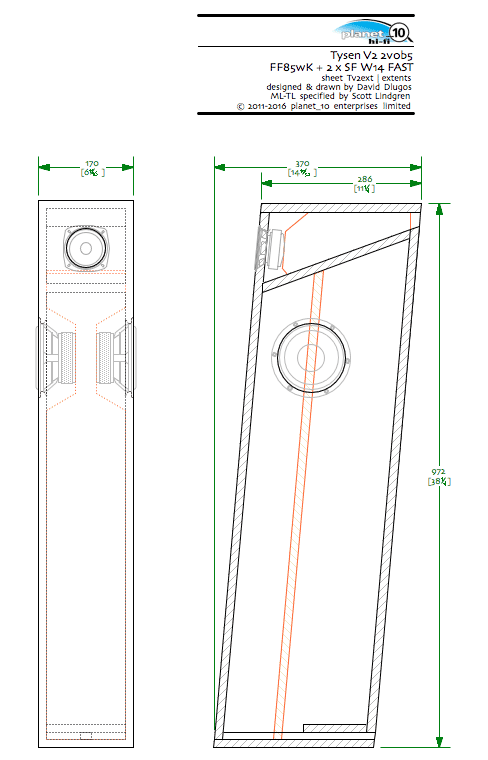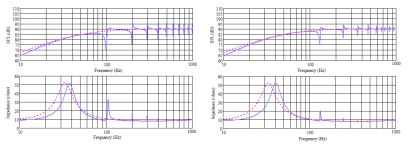"A sealed TL = a 1/2 wave pipe (i.e. a pipe sealed at both ends). Often used for midrange enclosures as an alternative to a simple sealed box, although sometimes, as in the case of the Nautilus, used for the LF also. Not novel, they've been around & used for decades. "
Ok, so half of what? Cant you just make design the depth very deep?
Ok, so half of what? Cant you just make design the depth very deep?
Yeah xrk971 has done some foam core builds on the concept as well. Search "dagger" and "nautalos".
Slackweather: half wave of the lowest frequency you want to reproduce. With TL you can go half or quarter wave.
Tmuikku: isn t the thread linked from Xrk971?
I ve forgotten about the Nautalos thank you to remind it! Iirc the dagger and all derivative come from(at least in this forum) an other idea as well, a kind of box without paralell walls. Can t remember name of it or the thread.
Edit: found it! HyperFAST - a Hypercube Based 2-Way
And the original hypercube thread: Hypercube Loudspeakers
The nautaloss thread: The Nautaloss Ref Monitor
Tmuikku: isn t the thread linked from Xrk971?
I ve forgotten about the Nautalos thank you to remind it! Iirc the dagger and all derivative come from(at least in this forum) an other idea as well, a kind of box without paralell walls. Can t remember name of it or the thread.
Edit: found it! HyperFAST - a Hypercube Based 2-Way
And the original hypercube thread: Hypercube Loudspeakers
The nautaloss thread: The Nautaloss Ref Monitor
Last edited:
"A sealed TL = a 1/2 wave pipe (i.e. a pipe sealed at both ends). Often used for midrange enclosures as an alternative to a simple sealed box, although sometimes, as in the case of the Nautilus, used for the LF also. Not novel, they've been around & used for decades. "
Ok, so half of what? Cant you just make design the depth very deep?
A pipe closed at both ends functions as a 1/2 wave resonator, the fundamental occuring at 1/2 wavelength of a frequency detemined by its axial length & any taper that might be present. The amplitude of the harmonic modes is also affected by the pipe profile. For example, figure 1 attached. FR & impedance of two sealed pipes of the same volume [nearly], and the same axial length, end-loaded by the same drive unit, left undamped for clarity.
Left column = untapered pipe.
Right column = 6:1 [contracting] taper ratio pipe.
Attachments
Last edited:
Any loudspeaker box and room has internal reflections and standing waves. Round, triangular, ellipsoid etc. are more difficult to simulate, but for rectangular boxes we can use room mode simulators.
The midrange driver is most severely challenged!
This is one of the nicest simulators
amroc - THE Room Mode Calculator
The midrange driver is most severely challenged!
This is one of the nicest simulators
amroc - THE Room Mode Calculator
The midrange driver is most severely challenged!
In general, or specifically in the case of the Nautilus?
"frequency you want to reproduce. With TL you can go half or quarter wave."
Interesting! Am I the only one here who has not included this factor?
But how is this affecting a mid range box? Let say this box will serve down to 100Hz.
Speed of sound 331m/sec.
331/100=3.3
3.3/4=0.8 meters
Please explain.
Interesting! Am I the only one here who has not included this factor?
But how is this affecting a mid range box? Let say this box will serve down to 100Hz.
Speed of sound 331m/sec.
331/100=3.3
3.3/4=0.8 meters
Please explain.
That’s about right. 2 x that length for 50 Hz. 2 x for 25 Hz. Shorter if it is tapered.
With a midrange or midTweeter TL (i call them midTLs) your goal is not get bass extension, its purpose is to suck up all back wave so that none comes back thru the cone. Damp more densly towards the terminus. You are aiming at an aperiodic alignment.
Here is one of ours. Heavy taper to minimize length (or more accurately to be able to maximize the available length). Bass is 2 5.25” push-push ML-TL. XO 250-450 Hz.

dave
With a midrange or midTweeter TL (i call them midTLs) your goal is not get bass extension, its purpose is to suck up all back wave so that none comes back thru the cone. Damp more densly towards the terminus. You are aiming at an aperiodic alignment.
Here is one of ours. Heavy taper to minimize length (or more accurately to be able to maximize the available length). Bass is 2 5.25” push-push ML-TL. XO 250-450 Hz.

dave
Right, although for clarity we should quickly note that for a given Vb & physical length, where tapering (narrowing toward the terminus) an open pipe lowers Fp, it raises it for a closed pipe.
What does Fp stand for?
Yes, I am catching up now, i understand thisis about absorbing the back wave effectively.
I like visually deep boxes myself, deep boxes often look poweful, but 80cm isnt really practical. So this is not really manageablr to do all the way down to 100Hz wit a straight line and no tapering (unless you can stand a design that is 80cm deep or deeper internally.).
But down to 200Hz one should get good damping with a cabinet that is 40cm deep with heavy glasswool to the back wall?
I like visually deep boxes myself, deep boxes often look poweful, but 80cm isnt really practical. So this is not really manageablr to do all the way down to 100Hz wit a straight line and no tapering (unless you can stand a design that is 80cm deep or deeper internally.).
But down to 200Hz one should get good damping with a cabinet that is 40cm deep with heavy glasswool to the back wall?
Heavy damping can kill dynamic.
Please explain this.
I don t want to loose you!
If you use too much damping material on a classic box (br or sealed) you ll have the subjective impression that the driver will loose dynamic potential. In the case of closed Tl same as Nautilus way, you don t have a lot of stuffing near the driver but the damping material will be used along the line and the closer the end of the seashell end (opposite to the driver) the more damping is used. The fact that rear end of driver is not muted in a closed TL compensate for the 'black hole' the line does... so you got subjective impression of dynamic with an acoustic short path too, best of both world (or an attempt to it).
Take a look at the Nautaloss thread linked in my previous post for pictures of it.
Edit: it is well known in acoustic that overdamped acoustic treatment (too much absorbtion) make the room unpleasant long term and in need to talk louder to be heard by other persons. Same thing happen inside a loudspeaker box. In the case of studio acoustic this one of the reason there is need for huge amount of power and big multiple woofer for mains speakers.
If you use too much damping material on a classic box (br or sealed) you ll have the subjective impression that the driver will loose dynamic potential. In the case of closed Tl same as Nautilus way, you don t have a lot of stuffing near the driver but the damping material will be used along the line and the closer the end of the seashell end (opposite to the driver) the more damping is used. The fact that rear end of driver is not muted in a closed TL compensate for the 'black hole' the line does... so you got subjective impression of dynamic with an acoustic short path too, best of both world (or an attempt to it).
Take a look at the Nautaloss thread linked in my previous post for pictures of it.
Edit: it is well known in acoustic that overdamped acoustic treatment (too much absorbtion) make the room unpleasant long term and in need to talk louder to be heard by other persons. Same thing happen inside a loudspeaker box. In the case of studio acoustic this one of the reason there is need for huge amount of power and big multiple woofer for mains speakers.
Last edited:
If you wish to absorb effectively all the sound propagating in a tunnel the length needs to be long enough to achieve it. Quarter wavelength, half wavelength is irrelevant. In addition the cross sectional area and stuffing type and density needs to vary in such way to give an impedance variation that minimises the amount of sound reflected particularly in the early part of the tunnel. This is why anechoic chambers have pyramid shaped wedges stuck to the walls. If it was solid foam a significant amount of sound would be reflected off the front face where there is a significant step change in impedance.
- Home
- Loudspeakers
- Multi-Way
- Was Nautilus bunk?
